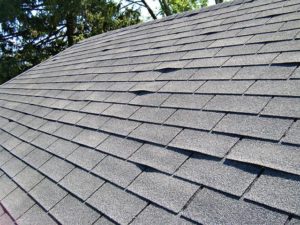 When asphalt shingles develop a pattern of curling that resembles a fish attempting to breathe while out of the water, contractors refer to this as fishmouthed shingles or fishmouth curling. This particular pattern can develop soon after installation or when the shingles are reaching the end of their life. Fishmouthed shingles can have a variety of causes. Residential roofing & curling shingles is a common question from residential owners.
When asphalt shingles develop a pattern of curling that resembles a fish attempting to breathe while out of the water, contractors refer to this as fishmouthed shingles or fishmouth curling. This particular pattern can develop soon after installation or when the shingles are reaching the end of their life. Fishmouthed shingles can have a variety of causes. Residential roofing & curling shingles is a common question from residential owners.
Residential Roofing & Curling Shingles – When Fishmouthing Occurs Soon After Installation
If the shingles fishmouth within the first six months of life, it is usually because the shingles have not relaxed enough to lay flat on the roof. The distortions will typically disappear over the following year, and any that remain can often be remedied through the use of an adhesive. New shingles that have fishmouthed are not more prone to leaks or wind damage and the roof’s life expectancy is not compromised.
When Fishmouthing Occurs Near the End of the Roof’s Expected Life
If the shingles have been in place for years, fishmouthing is usually a sign of age. The shingles are fragile, so they should not be walked on and homeowners should start making plans to replace the roof. However, unless the shingles are also cracked, broken or have lost their granules, fishmouthing does not always indicate that immediate replacement is necessary.
Causes of Fishmouthing
Unless the shingles are new, fishmouthing usually reveals a problem with moisture. In some cases, the moisture problem is related to the home itself, but it can also indicate improper handling of the shingles or incorrect installation.
• If the attic does not have proper ventilation, moisture can build up. When the moisture tries to escape through the decking, it can reach the underside of the shingles, which is the least waterproof part of an asphalt shingle. The moisture and exposure to the weather can cause fishmouthing, particularly at points where the edges of shingles meet.
• Even with good attic ventilation, if there is a source of moisture in the home, the humidity levels can build in the attic and penetrate to the underside of the shingles. For example, a wet basement or a broken pipe in a wall of the home can produce enough moisture to eventually reach the attic and damage the shingles.
• If shingles are not stored properly prior to installation, it is possible for rain to penetrate the wrappers. If the contractor then installs the wet shingles, the moisture becomes trapped underneath and fishmouthing can occur.
• Asphalt shingles are not entirely waterproof. The roof’s pitch, the nailing pattern and the placement of every tier of shingles contribute to the shingles’ ability to shed water. If the shingles are not installed correctly, moisture may seep beneath.
• Flashing plays an important role in keeping water from penetrating beneath shingles. If flashing is broken or missing, water may have an access point to flow between the shingles and the underlayment.
If Your Shingles Have Fishmouth Curling
Because fishmouthing can indicate additional problems, it is best to have a reputable roofing contractor conduct a thorough inspection to determine the cause. He can evaluate whether immediate replacement is warranted or whether the issue is strictly aesthetic.
